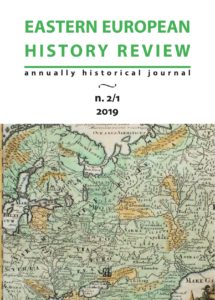
EASTERN EUROPEAN HISTORY REVIEW, n. 2-1 (2019)
Cesare La Mantia
UNIVERSITÀ DEGLI STUDI di TRIESTE
MEMORIA E VIOLENZA NELLA POLONIA DI FINE OTTOCENTO E INIZI DEL NOVECENTO
Abstract:
The Author analyzes the use of political violence and the legacy historical in Poland before and after the First World War. In particular, he focuses on the activities of the main political parties and the use of violence against the Jewish minority. The main causes of the repeated political use of violence are identified in the weakness of the international community at the time and the growing nationalism in the states born from the collapse of the central empire. According to the author, the inability of the winners of the war to solve the problem of minorities, and the pending issue of borders of the new states, as well as the spread fear of Communism expressed by frequent strikes and revolts of workers, have contributed to engross this violence escalation. In Poland, politically reborn after the war, the main parties used political violence to achieve their goals so creating the conditions for the assassination of the first president of the Polish Republic.
KEYWORDS: Contemporary History, History of Poland, History of Eastern Europe, Piłsudski. Dmowski.
Andrea Fara
SAPIENZA UNIVERSITÀ DI ROMA
“OPUS MECHANICUM SIVE PARVUM SIVE MAGNUM”. ARTI, MESTIERI E CORPORAZIONI NELLA TRANSILVANIA SASSONE (XIV-XVI SECOLO)
Abstract:
From the fourteenth and during the fifteenth century, the political stability of the kingdom of Hungary, the maturation of the institutions of Saxon hospites of Transylvania and the formation of the voivodships of Wallachia and Moldova beyond the Carpathians, favoured the economic growth of the Saxon communities of Transylvania and their coherent integration into the Saint Stephan’s domains and, more generally, in Western and Eastern Europe. The birth and development of the corporations in the Saxon territory were the direct consequence and the complementary testimony of this economic growth. In turn, guild organization proved to be an effective means of ensuring further economic, and therefore political and social, progress of the Saxon cities of Transylvania. In the sixteenth century, following the fall of the kingdom of Hungary and the creation of a formally
autonomous Principality that did not suffer any occupation and even managed to maintain a position of substantial balance between the Ottoman Empire and the Habsburgs, Transylvania lived a period of relative tranquillity. In this context, throughout the territory of the ancient kingdom of Saint Stephan, the guild system kept alive in the Terra Saxonum particularly, and, although in strongly crystallized forms, during the century it also extended to smaller urban communities and even to those of village, maintaining a high level of production.
KEYWORDS: Crafts, Hungary, Transylvania, Saxons, Middle Ages.
Jarosław Pietrzak
PEDAGOGICAL UNIVERSITY IN KRAKÓW
A WIFE FOR THE PRETENDER. CONCERNING THE MARRIAGE BETWEEN MARIA CLEMENTINA SOBIESKA AND JAMES FRANCIS EDWARD STUART 1718-1720
Abstract:
The paper tries to consider the history of Maria Clementina Sobieska’s journey to Italy between 1718 and 1719 in connection with her wedding to James Francis Edward Stuart, the so-called ‘Old Pretender’. The following topics are considered in this work: the situation of the Stuarts, in exile in France and later in Italy, looking for candidate wife for James F. E. Stuart; the choice of Maria Clementina Sobieska – the granddaughter of the Polish king John III Sobieski and her imprisonment by the Emperor Charles VI during the trip to Italy. In particular, the political power systems are also considered, in particular the Anglo-Austrian relations which determined the course of events. Thanks to the new arrangements, it was possible to describe the prison life of Sobieska in Ambras and the efforts to release her taken by her father Prince James Sobieski and her future husband James F. E. Stuart.
A new perspective upon such political problems are brought to light by the archival query conducted in the Windsor Royal Archives, the National Archives of the United Kingdom, the British Library in London, the National Archives of Belarus in Minsk and several archives and science libraries in Poland.
KEYWORDS: Maria Clementina Sobieska; Stuarts; Pretenders; Italy.
Francesca Ceci
Musei Capitolini
JAN E MARYSIEŃKA. RIFLESSIONI E AGGIORNAMENTI SULLE MEMORIE DI JAN III SOBIESKI E MARIA CASIMIRA NEI MUSEI CAPITOLINI A ROMA (Reflections and updating about the Jan III Sobieski and Maria Casimira’s memories at the Capitoline Museums of Rome)
Abstract:
This paper presents two marble epigraphs preserved at the Capitoline Museums of Rome. Relating to King Jan III Sobieski and his wife Maria Casimira Luisa de la Grange d’Arquien, mostly unpublished.
In the first – dedicated by the Senate to Innocent XI to commemorate the victory of Vienna on 12 September 1683 – we find the engraved names of the protagonists of this famous historical event.
In the second – surmounted by a precious marble low-relief bust of the widowed Queen Maria Casimira – we can learn of her merits, and specifically her influence on her husband, urging him to act on the occasion of the battle of Vienna in 1683, but also the later coming to Rome driven by pietas to celebrate the 1700 Jubilee.
It is thanks to the archival research conducted by Jennifer Montagu that we came to know the sculptor of the queen’s portrait Lorenzo Ottoni, a well-established and fruitful sculptor of the time.
KEYWORDS: Musei Capitolini, Sobieski Family, Epigraphs
Book Review:
Sonia Melchiorre
UNIVERSITÀ DELLA TUSCIA
THE QUEEN TAKES CENTRE STAGE IN HISTORY MEDIA COVERAGE. FRANCESCA DE CAPRIO’S MARIA LUISA GONZAGA NEVERS. CERIMONIE E PROPAGANDA NEL VIAGGIO VERSO DI TRONO DI POLONIA (1645-1646).
In Memory
István György Tóth
“IN HUNGARY EVEN THE SMALL CHILDREN ALL SPEAK LATIN…”
THE SPOKEN LATIN IN EARLY MODERN HUNGARY – MYTHS AND REALITY